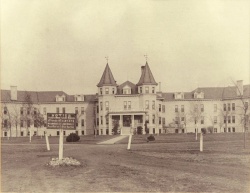Rock County Insane Asylum
| Rock County Asylum | |
|---|---|
 | |
| Established | 1881 |
| Opened | 1894/1925 |
| Current Status | Demolished |
| Building Style | Cottage Plan |
| Architect(s) | Rowe, Dillard & Rowe |
| Location | Janesville, WI |
| Architecture Style | Neoclassical |
| Alternate Names |
|
History[edit]
In 1881 The Rock County Asylum opened. Through the efforts of the State Board of Charities and Reform, a statute was enacted that finally crystallized the county care system. The operation of the Rock County Asylum became official in 1881. Residents were referred to as inmates. The number of inmates continued to grow. It became evident that additional farmland was needed to keep the inmates profitably busy.
The county moved the Rock County Asylum and Poor Farm to 350 acres on highways 51 and 14 in 1894. Back then, able residents worked the land that provided their food. The Poor Farm and Asylum continued to be managed with the inmates doing the bulk of the work. Very little was publicly said regarding the management of the Poor Farm and County Asylum by 1911. The facility was known as the County Farm, Poor House, Insane Asylum and County Hospital. Over the next 50 years, long-term care consisted of food, clothing, lodging and social supervision but did not include treatment by professional staff. “Deviants” of the community, were confined to the county farm. These included epileptics, unwed mothers, drug abusers, and prostitutes.
In 1925 The Alpha Building opened as the “Women’s Residence”. Women living in the Alpha building worked in the kitchen and the laundry. Then in 1939 The Beta Building opened as the “Men’s Residence”. Men living in the Beta Building worked in the laundry and on the farm. The original asylum building was demolished sometime in the 1960s.
After fifteen years of planning and numerous set backs, Rock Haven was built and admitted its first resident in December 1964. Rock Haven, a skilled nursing home, had a capacity of two hundred and forty-eight beds. All chronic patients in Rock County, however, were excluded from psychiatric services and continued to be “warehoused”. Also that year the Beta Building was converted to the active treatment (or “DATO unit”). In later years, it housed the Public Health Department.
By 2007 most of the older buildings were demolished & several of the others were converted to other uses by the county government.





